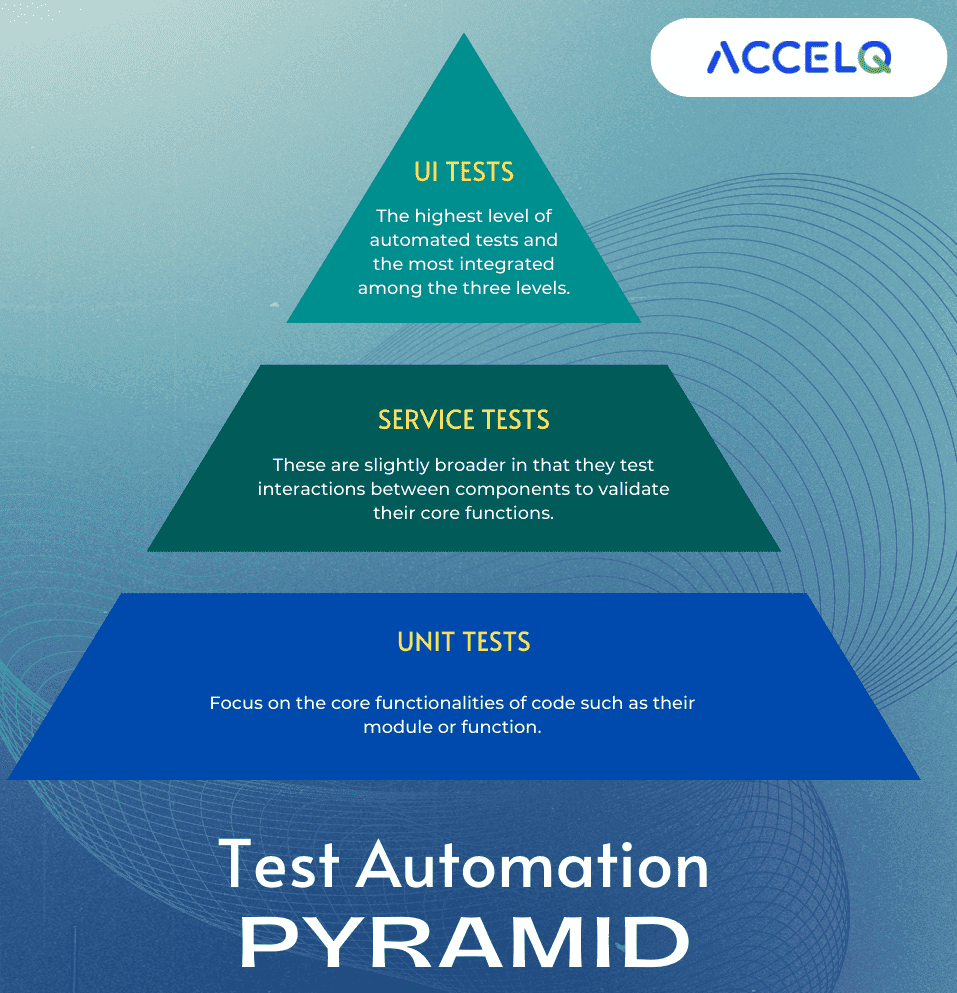The Test Automation Pyramid: What is it & How to Use it in 2025

In a modern software development world, delivering high-quality releases while keeping quick deployment cycles is challenging. The Test Automation Pyramid concept by Mike Cohn gives a framework for how to balance automated testing. This framework separates tests into multiple types (e.g., unit tests, service tests, and UI tests), allowing a team to optimize their tests and eliminate redundancy where appropriate.
When you deploy the same principles to agile software development, the automated test pyramid helps detect bugs quickly, provides ongoing feedback, and scales the testing process. This article will discuss the test automation pyramid, which explains how it works and how to implement it in agile development to achieve the right software quality.
What is the Test Automation Pyramid?
The test automation pyramid in Agile is a framework that structures automated testing into three primary levels:
| Test Level | Purpose | Scope |
|---|---|---|
| Unit Tests | Validate individual functions and modules. | Narrow, code-level testing. |
| Service Tests (API Tests) | Ensure interactions between components work correctly. | Medium scope, business logic validation. |
| UI Tests | Verify user interface functionality and experience. | Broadest scope, end-to-end validation. |

This pyramid structure prioritizes lower-level automated tests (unit and service tests) as they are faster, more reliable, and cost-effective compared to UI tests.
Key Characteristics of the Test Automation Pyramid:
- Unit Tests: Small, fast, and executed frequently; validate code correctness.
- Service Tests: Ensure APIs and service layers interact as expected.
- UI Tests: Simulate real user interactions but are slower and more prone to flakiness.
By balancing test levels, teams can optimize testing efforts, reduce maintenance costs, and improve agility.
Benefits of the Test Automation Pyramid
Implementing the software testing pyramid provides several advantages in agile development:
| Benefit | Description |
|---|---|
| Early Bug Detection | Catches defects early in the development lifecycle. |
| Reduced Test Maintenance | Minimizes reliance on high-maintenance UI tests. |
| Faster Feedback Loops | Accelerates test execution for rapid development cycles. |
| Cost Efficiency | Reduces rework and debugging costs by shifting testing left. |
| Improved Test Coverage | Ensures a balanced test strategy across all layers. |
| Scalability | Supports continuous testing in agile and DevOps pipelines. |
| Better Compliance | Helps organizations meet industry standards and security regulations. |
| Higher Stability | Reduces flaky test results and enhances software reliability. |
ACCELQ's AI-powered automation facilitates a smooth adoption of the test pyramid automation - as low Code/no Code test automation is easy, it supports business partners and Agile teams with scalable testing solutions.
How to Implement the Test Automation Pyramid in Agile Development
1. Focus on Unit Testing
Unit tests should form the foundation of your test strategy. Since they validate individual functions, they run fast and provide quick feedback.
- Write testable, modular code.
- Automate unit testing using frameworks like JUnit, NUnit, or PyTest.
- Integrate unit tests into CI/CD pipelines.
- Execute unit tests with every code commit to prevent regressions.
2. Leverage Service-Level Testing
Service tests(or API tests) verify backend logic and data flow between different components.
- Use tools like Postman, RestAssured, or ACCELQ for API automation.
- Ensure coverage for authentication, data validation, and error handling.
- Implement contract testing for microservices architectures.
- Enable mocking and stubbing to simulate external service interactions.
3. Optimize UI Testing
UI tests should be minimal but essential for ensuring the end-user experience remains intact.
- Automate UI testing using Selenium, Cypress, or ACCELQ.
- Prioritize critical user journeys and avoid excessive UI automation.
- Use visual regression testing to catch UI inconsistencies.
- Execute UI tests in parallel to minimize execution time.
4. Integrate Testing into CI/CD Pipelines
Continuous Integration and Deployment (CI/CD) ensures automated tests run seamlessly throughout development.
- Automate test execution on every commit.
- Run fast tests (unit, service) first, then execute UI tests.
- Utilize containerized test environments (e.g., Docker, Kubernetes).
- Employ AI-driven testing orchestration to prioritize high-impact test cases.
5. Maintain a Balanced Test Suite
Avoid overloading any test layer—too many UI tests slow execution, and too few service tests risk missing API-level bugs.
- Use test coverage analysis to measure effectiveness.
- Prioritize test refactoring to reduce redundancy.
- Implement data-driven testing for scalable test scenarios.
- Regularly assess test flakiness and update scripts accordingly.
By adopting the agile testing pyramid, teams create a resilient automation framework that supports continuous testing, early defect detection, and faster releases.
The Role of the Test Automation Pyramid in Agile & DevOps
Agile teams must iterate quickly while maintaining quality. The test automation pyramid in agile enables this by ensuring testing efforts align with agile and DevOps best practices:
| Aspect | How the Test Pyramid Helps |
|---|---|
| Continuous Testing | Enables automated testing at every development phase. |
| Shift-Left Approach | Detects issues earlier, reducing technical debt. |
| Parallel Execution | Runs tests simultaneously to accelerate feedback. |
| Scalability | Supports microservices and cloud-based applications. |
| DevSecOps Integration | Ensures security is part of the testing process. |
As companies adopt DevOps methodologies, leveraging the test automation pyramid ensures stable, high-quality software releases while accelerating delivery timelines.
Common Challenges & Solutions in Implementing the Test Automation Pyramid
| Challenge | Solution |
|---|---|
| Over-reliance on UI Tests | Shift testing to unit and API layers for better efficiency. |
| Slow Test Execution | Optimize test suites by eliminating redundant UI tests. |
| Flaky Tests | Implement retry mechanisms and stabilize UI tests. |
| Limited Test Coverage | Increase API test adoption for broader validation. |
| Complex Test Data Management | Use test data management tools for structured automation. |
| Lack of Test Visibility | Implement test reporting dashboards for real-time insights. |
Agile teams can navigate through this by iteratively evolving their test automation strategy, using AI-powered automation platforms like ACCELQ to bring efficiency into their testing cycles.
Conclusion
The test automation pyramid is a significant strategy for agile and DevOps teams wanting to elevate software quality, lower testing costs, and make releases faster. Organizations can optimize their testing by dividing their tests into unit, service, and UI layers for maximum efficiency.
By embracing the test automation pyramid in agile, development teams can achieve higher-quality releases, reduced testing costs, and improved project efficiency, ensuring sustainable software success in an evolving digital landscape.
Geosley Andrades
Director, Product Evangelist at ACCELQ
Geosley is a Test Automation Evangelist and Community builder at ACCELQ. Being passionate about continuous learning, Geosley helps ACCELQ with innovative solutions to transform test automation to be simpler, more reliable, and sustainable for the real world.
Discover More
 AI Automation in Testing: The Future of Smarter, Scalable QA
AI Automation in Testing: The Future of Smarter, Scalable QA
AI Automation in Testing: The Future of Smarter, Scalable QA
 Challenges in Achieving In-Sprint Automation and Solutions
Challenges in Achieving In-Sprint Automation and Solutions
































